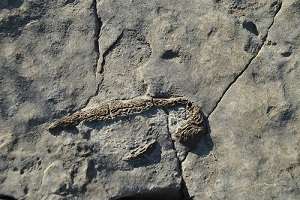Reef fossil find sets new age limit

An organic geochemist has found fat molecules within fossilised remains in the central Kimberley's Devonian Reef.
Curtin University PhD candidate Ines Melendez says the lipids are 380 million years old, or about 250 million years older than what had been the oldest known find of its kind.
"This is the first detailed molecular study … on a carbonate concretion from the Devonian Reef," she says.
Her supervisor, Professor Kliti Grice, says the fossil was originally a crustacean that died in the oceans around the time of the Devonian mass-extinctions (more than 360 million years ago).
It fed on smaller organisms in the oxygenated upper layer of water, and when it died it sank into a lower layer of anoxic water.
"Sulfate reducers degrade that organic matter anerobically, yielding hydrogen sulfide utilised in photosynthesis by organisms called Chlorobi at the interface between the oxygenated and anoxic layers," Prof Grice says.
Ms Melendez says these microbes then formed a community around the dead crustacean.
"There was so much organic matter that they didn't degrade everything," she says.
"The conditions helped these organisms to start to precipitate carbonate—whatever was left was encapsulated inside and wasn't used any more.
"In that way the concretion kept growing."
She analysed the fossil, finding molecules of 70 different steroids.
This includes the original sterol from the algae in the oxygenated part of the ocean, cholesterol from the crustacean itself, and a range of compounds formed by the Chlorobi and sulfate-reducing bacteria.
Ms Melendez says it was an unusual opportunity to analyse a carbonate concretion containing a well-preserved fossil.
"This one is not a beautiful fossil from a paeleontological point of view so we were allowed to destroy it," she says.
"We didn't know if we were able to get biomolecules or geomolecules [molecular fossils] out but when we tried a lot of organic geochemical approaches a lot was observed."
Professor Grice says the research was prompted by the desire to better understand the region's petroleum resource and the reconstruction of molecular fossils associated with carbonate concretions and the Devonian extinctions.
"We were looking at originally the Gogo shales which is the source of oil in the Canning Basin," she says.
"That spans an extinction boundary."
Prof Grice hopes it will stimulate further research.
"It might change some concepts, particularly in the petroleum industry because some of the molecules which have been found here are actually microbially formed," she says.
"Traditionally they were thought to be formed by thermal processes."
Other compounds found in the fossil included aromatic steroidal hydrocarbons often found in petroleum.
Provided by Science Network WA




















